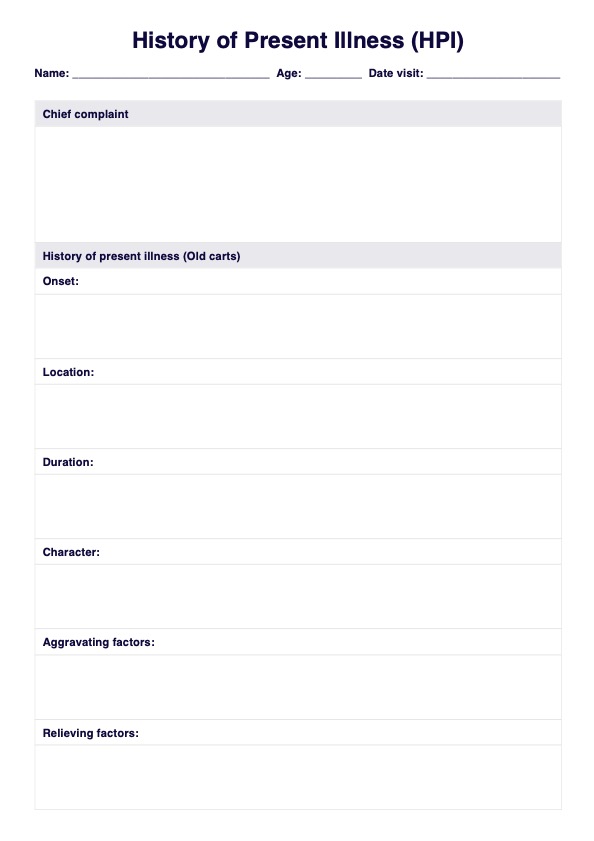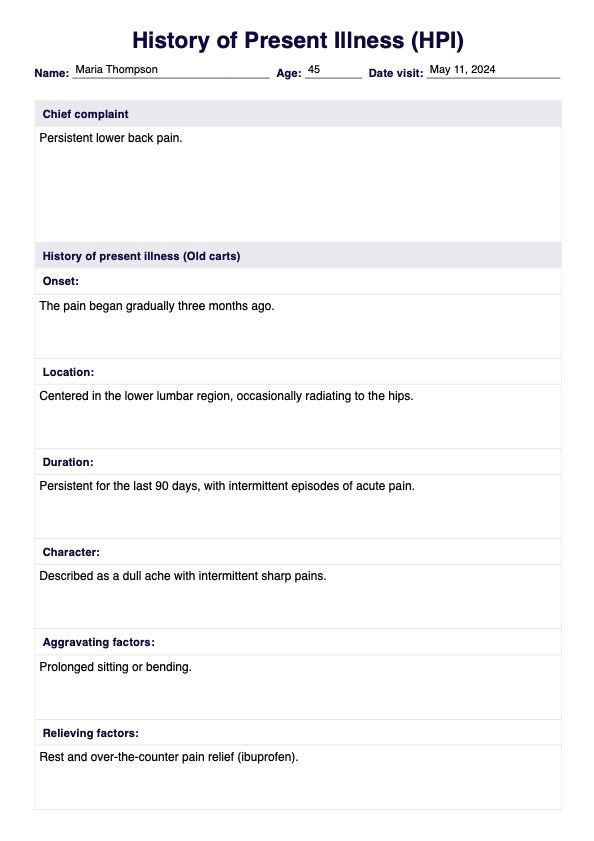HPI Template
Download our comprehensive HPI Template to streamline and improve the collection of a patient's history of present illness (HPI), which is essential for accurate diagnosis and treatment planning.


What is history of present illness (HPI)?
The History of present illness (HPI) is a detailed, chronological description of the development of the patient's illness from the first sign or symptom to reach the present. It forms a component of the medical history, capturing critical details about the patient's complaints.
Understanding the HPI is crucial as it helps healthcare providers diagnose and manage patients more effectively. It provides context to the patient’s current health status and can reveal the severity and impact of the condition on the patient's life.
HPI Template
HPI Template Example
How to obtain a patient's history of present illness?
To effectively gather a patient's history of present illness (HPI), healthcare providers can use the OLD CARTS mnemonic as a guide for short, structured interviewing. This approach ensures a comprehensive assessment of the patient's condition by covering all crucial aspects of their symptoms:
- Onset: When did the symptoms start?
- Location: Where is the symptom located?
- Duration: How long have the symptoms been going on?
- Character: What is the nature of the symptom (e.g., sharp, dull, throbbing)?
- Aggravating factors: What makes the symptoms worse?
- Relieving factors: What makes the symptoms better?
- Timing: Are the symptoms constant, or do they come and go?
- Severity: How severe are the symptoms on a scale of 1 to 10?
By methodically addressing each of these categories, healthcare providers can capture a detailed and actionable history that aids in effectively diagnosing and managing the patient's condition.
How does our HPI template work?
To effectively utilize our HPI template:
- Download our template: Our structured printable HPI template is designed to streamline the data collection process during patient assessments.
- Systematic data entry: The template guides clinicians through essential questions and fields tailored to capture detailed and relevant information about the patient's illness.
- Comprehensive coverage: Using our template, clinicians can ensure that no critical information is overlooked, from the onset and severity of symptoms to their impact on daily activities.
- Documentation efficiency: This structured approach not only aids in the accurate collection of the HPI but also enhances the efficiency of documentation, allowing for a smoother and faster patient interview process.
By following these steps, healthcare providers can leverage our HPI template to ensure thorough and accurate patient assessments occur, aiding in effective diagnosis and management.
Benefits of having an HPI template
The benefits of utilizing our free HPI (History of Present Illness) template are extensive, particularly in streamlining the diagnostic process in various medical settings such as emergency departments and routine clinical practices. Here are some additional benefits:
Standardized data collection
An HPI template standardizes the collection of critical patient information for accurate and comprehensive medical records. By ensuring that all relevant details, such as the onset, location, and severity of symptoms, are consistently recorded, the template minimizes the risk of omitting crucial information.
Enhanced communication
Using a standardized HPI template improves communication among healthcare providers. When everyone uses the same format, it is easier to understand and follow the patient's history and symptoms. This is particularly valuable in emergency medical services, where time and clarity are crucial.
Efficiency in patient care
Templates accelerate the gathering of health histories by providing a clear and concise framework for healthcare providers to follow. This efficiency saves time during patient interviews and speeds up decision-making, allowing for quicker interventions.
Educational tool
An HPI template is an excellent educational tool for new healthcare providers or students. It helps them learn what critical information needs to be gathered and how to organize it effectively.
Facilitates comprehensive assessment
The template prompts the healthcare provider to explore various aspects of the patient's condition (such as associated symptoms and exacerbating or relieving factors), ensuring a thorough assessment and laying a solid foundation for diagnosis and treatment planning.
Overall, an HPI template is an invaluable asset found in medical practice every day. It enhances the quality of patient care through improved data accuracy, efficiency, and communication among healthcare providers.
What to do after completing the HPI?
After completing the History of Present Illness (HPI), the next step typically involves conducting a thorough physical examination to assess the patient further. This examination allows healthcare providers to verify symptoms mentioned during the HPI and identify any additional relevant signs.
Based on the findings from the HPI and the physical exam, appropriate diagnostic tests might be ordered to investigate the symptoms more deeply. These tests help to confirm a diagnosis, rule out certain conditions, or monitor the severity of the disease.
This process is crucial, especially in settings like emergency departments or during initial consultations in medical services, in cases where a precise understanding of the patient's condition can significantly impact treatment decisions. This systematic approach ensures that all relevant clinical information is considered before making a final diagnosis or treatment plan.
Commonly asked questions
Typically, any healthcare provider involved in patient assessment can complete an HPI, including physicians, nurse practitioners, physician assistants, and sometimes registered nurses, particularly in emergency department settings where detailed patient histories are crucial.
Accuracy is crucial as the chief complaint guides the direction of further questions and examinations performed, directly impacting the diagnostic process and subsequent treatment plans.
Medications can affect symptoms by alleviating them or causing side effects that may confuse the clinical picture. Thus, understanding a patient's medication regimen is essential for accurately interpreting symptoms and their severity.

.jpg)





































































































